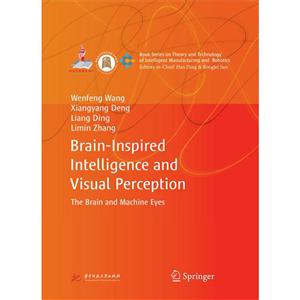-
>
宇宙、量子和人类心灵
-
>
(精)BBC地球故事系列-星际旅行
-
>
从一到无穷大
-
>
图说相对论(32开平装)
-
>
一本有趣又有料的化学书
-
>
刘薰宇的数学三书:原来数学可以这样学全3册
-
>
光学零件制造工艺学
Brain-Inspired Intelligence and Visual Perception 版权信息
- ISBN:9787568050791
- 条形码:9787568050791 ; 978-7-5680-5079-1
- 装帧:一般胶版纸
- 册数:暂无
- 重量:暂无
- 所属分类:>>
Brain-Inspired Intelligence and Visual Perception 本书特色
In the 19th century, Spanish anatomists founded the theory of neurons. With the development of brain science, the biological characteristics of neurons and related electrical properties have been discovered. The advent of mathematical methods to simulate the actual human neural network in 1943 can be recognized as one of the notable landmarks. 63 years since then, deep neural networks were proposed and developed to simulate the structure of the human cerebral cortex. The emergence of deep learning has a great influence on the traditional artificial intelligence and enhanced the importance of brain-inspired intelligence in the whole field of artificial intelligence. This is a great dream into reality!
Brain-Inspired Intelligence and Visual Perception 内容简介
In the 19th century, Spanish anatomists founded the theory of neurons. With the development of brain science, the biological characteristics of neurons and related electrical properties have been discovered. The advent of mathematical methods to simulate the actual human neural network in 1943 can be recognized as one of the notable landmarks. 63 years since then, deep neural networks were proposed and developed to simulate the structure of the human cerebral cortex. The emergence of deep learning has a great influence on the traditional artificial intelligence and enhanced the importance of brain-inspired intelligence in the whole field of artificial intelligence. This is a great dream into reality!
Brain-Inspired Intelligence and Visual Perception 目录
Brain-Inspired Intelligence and Visual Perception 作者简介
Wenfeng Wang is currently the leader of a CAS “Light of West China” Program (XBBS-2014-16) and has been invited as the director of the Institute of Artificial Intelligence, the College of Brain-inspired Intelligence, Chinese Academy of Sciences (to be set up in Nov. 2017). He also serves as a Distinguished Professor and the academic director of the R&D and Promotion center of artificial intelligence in the Robot Group of Harbin Institute of Technology, Hefei, China. His major research interests include functional analysis and intelligent algorithms with applications to video surveillance, ecologic modelling, geographic data mining and etc. He is the editor in chief of the book COMPUTER VISION AND MACHINE COGNITION (in Chinese), which has been published by Beihang University in China. Wenfeng Wang is enthusiastic in academic communications in any way and he served as PC members and Session chairs of a series of international conferences associated with the brain-inspired intelligence and visual cognition, including the 2017 IEEE International Conference on Advanced Robotics and Mechatronics, the 2017 International Conference on Information Science, Control Engineering and the 3rd International Conference on Cognitive Systems and Information Processing and etc. Xiangyang Deng is currently a full assistant professor with the Institute of Information Fusion, Naval Aeronautical University, Yantai, China. His current research interests include video big data, deep learning and computational intelligence. Xiangyang Deng has rich experience in R & D management. He won 3 First Class Prizes and 2 Third Class Prizes of Military Scientific and Technological Progress Award. He published 9 papers about the topics in the past 3 years while 5 of them were indexed by SCI, EI. He contributed to a monograph SWARM INTELLIGENCE AND APPLICATIONS (in Chinese), which was published by National Defense Industry Press. He has 2 patents and obtained 3 items of software copyright. Liang Ding is currently a full Professor with the State Key Laboratory of Robotics and System, Harbin Institute of Technology, Harbin, China. His current research interests include intelligent control and robotics, including planetary rovers and legged robots. Dr. Ding was a recipient of the 2017 ISTVS Söhne-Hata-Jurecka Award, the 2011 National Award for Technological Invention of China and the 2009/2013/2015 Award for Technological Invention of Heilongjiang Province. He received the Hiwin Excellent Doctoral Dissertation Award, the Best Conference Paper Award of IEEE ARM, and the Best Paper in Information Award of the 2012 IEEE ICIA Conference. Liang Ding is an influential scientist in intelligent control of robots and has published more than 120 authored or co-authored papers in journals and conference proceedings. Limin Zhang is currently a Full Professor and Tutor for Doctor with the Institute of Information Fusion, Naval Aeronautical University, Yantai, Shangdong, China. He was a senior visiting scholar at university college london (UCL) Modern Space Analysis and Research Center (CASA) from 2006 to 2007. His current research interests include signal processing, Complex system simulation and computational intelligence. More than 180 papers are published and 80 papers are indexed by SCI, EI. 2 monographs are published and 20 patents are applied and 6 were authorized. Limin Zhang has won two Second Class Prizes of National Scientific and Technological Progress Award and five First Class Prizes of Military Scientific and Technological Progress Award. He has been selected as outstanding scientists in national science and technology and millions of talents in engineering research field and he is enjoying special allowance from the State Council.
- >
烟与镜
烟与镜
¥20.6¥48.0 - >
名家带你读鲁迅:朝花夕拾
名家带你读鲁迅:朝花夕拾
¥10.5¥21.0 - >
史学评论
史学评论
¥13.9¥42.0 - >
伯纳黛特,你要去哪(2021新版)
伯纳黛特,你要去哪(2021新版)
¥15.9¥49.8 - >
龙榆生:词曲概论/大家小书
龙榆生:词曲概论/大家小书
¥9.1¥24.0 - >
企鹅口袋书系列·伟大的思想20:论自然选择(英汉双语)
企鹅口袋书系列·伟大的思想20:论自然选择(英汉双语)
¥6.3¥14.0 - >
山海经
山海经
¥21.8¥68.0 - >
经典常谈
经典常谈
¥17.1¥39.8
-
相对论
¥10.2¥32 -
数学物理方法
¥13.2¥27 -
2022图书×抽奖盲袋
¥9.9¥25 -
2023读书月阅读盲盒——天黑,闭眼,刀谁?
¥42.3¥158 -
2022读者节纪念徽章-三星会员专属
¥45¥45.6















